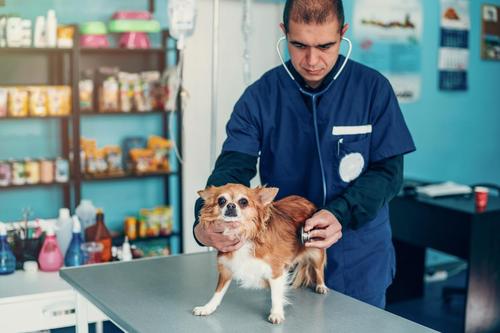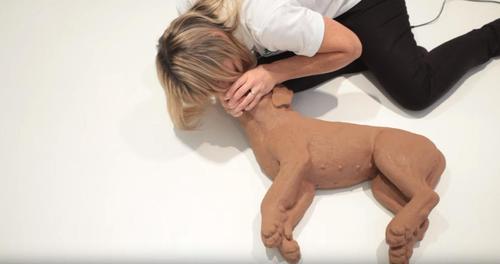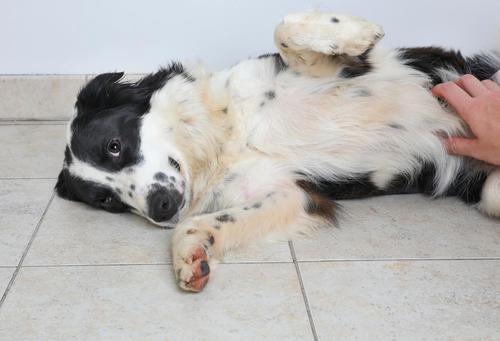Pet Owners Can Learn At-Home CPR To Save A Dog's Life
Sep 20, 2019 by apost team
Sometimes things happen to our furry friends and there may not be enough time to get them to a veterinarian. That’s why it’s important to know a technique that could help save your pup if the situation calls for it.

First, check to see if your dog is breathing. You can do this by holding your hand or your cheek up to their nose and feeling/listening for air. Also, watch for the rise and fall of their chest. If they are not breathing, check their airway for any blockage. Pull the tongue forward and remove any objects in the throat or mouth.

apost.com
Check if your pup has a pulse
 istockphotos.com/VioletaStoimenova
istockphotos.com/VioletaStoimenova
The femoral artery is the easiest place to find your dog's pulse and it is located on the inner thigh. Run your hand along the inside of the hind leg until you are almost to the point where the leg joins with the body. There you should feel a slight dip where the femoral artery is nearest to the skin. Use your fingers (not your thumb) to press down gently and feel for a pulse.
 istockphotos.com/joshuaraineyphotography
istockphotos.com/joshuaraineyphotography
If your dog has a pulse but is not breathing, you can perform artificial respiration. If your dog does not have a pulse, you will need to perform CPR, or Cardiopulmonary Resuscitation, which is both artificial respiration and chest compressions. Below you will find how to perform CPR on your dog as cited from the Canine Journal:
Note: Do NOT practice CPR on a healthy dog. CPR can cause serious physical damage to dogs if done unnecessarily.
 istockphotos.com/bloodstone
istockphotos.com/bloodstone
1. Position Your Dog For CPR
-
Put your dog on a stable, flat surface with their right side down.
-
Straighten their head and neck to create a direct passage for their airway.
-
Pull the tongue forward so that it is against the back of their teeth and close their mouth.
-
Place yourself behind their back.

2. Locate The Heart And Get Ready For Compressions
-
Place both of your hands, one over the other, on top of the widest part of the rib cage, near the heart, but not directly over it.
*For smaller dogs weighing 30lbs (13.6kg) or less, cup your hands around the dog’s rib cage, placing your fingers on one side of the chest and your thumb on the other.

3. Begin Compressions
-
Keeping both elbows straight, push down on the rib cage in firm, quick movements. Only push 1/4 to 1/3 of the chest width.
-
Repeat compressions at a quick rate of 15 per 10 seconds.
*For smaller dogs, use your thumb and fingers to squeeze the chest to about a 1/4 or 1/3 of its width. Repeat this at a slightly quicker pace than for larger dogs, aiming for 17 compressions in 10 seconds.

4. Begin Artificial Respiration
If performing CPR alone, give your dog artificial respiration after each set of 15 compressions.
-
Begin by sealing the dog’s lips. Place your hand over the dog’s snout and ensure the mouth is completely shut.
-
Next, cover your mouth over the dog’s nostrils and blow gently, watching for the chest to lift and expand. If the chest does not rise, blow harder into the nostrils and check that the mouth is properly sealed.
*For smaller dogs, place your mouth over their entire snout. -
Remove your mouth from the nose between breaths to allow for air return.
Give one breath for every 15 compressions.
*If there are two people available to perform CPR, have one person do compressions, while the other gives artificial respiration after every five compressions.
If you are only performing artificial respiration, follow the same procedure as above for sealing your dog’s mouth, and administer one breath every two to three seconds at a steady pace of 20 to 30 breaths per minute.
 istockphotos.com/GeorgePeters
istockphotos.com/GeorgePeters
5. Give An Abdominal Squeeze
-
Place your left hand under your dog’s abdomen, and your right hand on top. Push down to squeeze the belly and assist in the circulation of blood back to the heart.
-
Give one abdominal squeeze after each set of 15 compressions and one breath.
6. Repeat
Continue CPR or artificial respiration until the dog starts to breathe on its own and has regained a pulse. If the dog is not breathing after 20 minutes, it’s time to consider discontinuing treatment, as it is not very likely you will have success after this point.
Have you ever performed CPR on a dog before? Tell us below. Send this article to your friends and family who should know about this.